Honeywell International Bundle
How does Honeywell Dominate its Markets?
Honeywell International, a titan in technology and manufacturing, has consistently adapted its sales and marketing strategies to maintain a competitive edge. From its early days as a heating solutions provider to its current status as a global leader, Honeywell's evolution reflects a mastery of market dynamics. This exploration delves into the core strategies that drive Honeywell's success, offering insights into their sophisticated approach to sales and marketing.
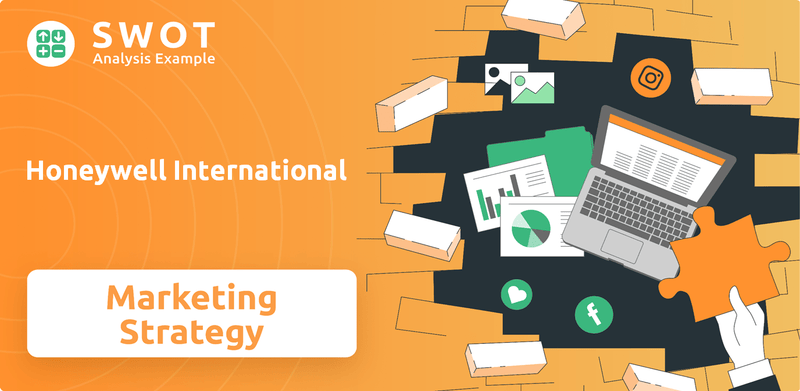
This analysis will dissect Honeywell's Honeywell International SWOT Analysis, sales processes, and marketing campaigns, providing a comprehensive view of its business model. We'll examine how Honeywell employs data-driven strategies to enhance its market share and navigate the complexities of the industrial sector. Understanding Honeywell's approach offers valuable lessons for any business seeking to refine its sales and marketing efforts.
How Does Honeywell International Reach Its Customers?
The sales channels of Honeywell International are designed to maximize market reach and cater to diverse customer needs. The company employs a multifaceted strategy that combines direct sales, wholesale distribution, and e-commerce platforms. This approach ensures that Honeywell can effectively serve its global customer base across various sectors, including aerospace, building technologies, and performance materials.
Honeywell's sales strategy is deeply rooted in its history of strategic mergers and acquisitions. These moves have provided access to patents and expanded its international presence. Today, the company maintains a robust and expansive distribution network, which includes a significant number of manufacturing facilities and a dedicated sales team.
The evolution of Honeywell's sales channels reflects a strategic shift toward digital adoption and omnichannel integration. Honeywell has invested in e-commerce platforms and online marketplace integrations to enhance accessibility and reach a broader audience. This is further supported by a focus on digital transformation initiatives, including the adoption of IoT technologies and cloud-based solutions, which streamline distribution and logistics management.
Honeywell's direct sales teams are a crucial part of its sales strategy, especially in complex B2B markets. These teams, comprising over 1,800 sales representatives, focus on building relationships with key clients and providing tailored solutions. This approach allows for a deep understanding of customer needs and the ability to offer customized products and services.
Wholesale distributors play a vital role in expanding Honeywell's market reach. These partners help distribute products to a wide range of customers, especially in regions where direct sales may not be as efficient. This channel is particularly important for reaching smaller businesses and end-users.
Honeywell has invested in e-commerce platforms to improve accessibility and cater to the growing demand for online purchasing. These platforms enable customers to easily browse and purchase products, streamlining the sales process. This digital presence is crucial for reaching a broader audience and staying competitive.
Strategic partnerships, such as those with aerospace giants like Boeing and Lockheed Martin, are essential for Honeywell's market reach. These collaborations allow for cross-leveraging of expertise and technology, contributing significantly to sustained growth and market share. These partnerships amplify market reach and allow for cross-leveraging of expertise and technology.
Honeywell's sales strategy is a blend of traditional and modern approaches, adapting to market changes and technological advancements. The company's focus on digital transformation and strategic partnerships, along with its historical growth through mergers and acquisitions, showcases its adaptability and forward-thinking approach.
- Global Presence: A distribution network spanning 75 countries, including 37 manufacturing facilities in North America, 28 in Europe, and 42 in Asia-Pacific.
- Digital Transformation: Investment in e-commerce platforms and online marketplace integrations to enhance accessibility and reach.
- Strategic Partnerships: Collaborations with industry leaders like Boeing and Lockheed Martin to amplify market reach.
- Adaptability: Demonstrated ability to pivot distribution and production strategies, such as during the pandemic, to meet market needs.
Honeywell International SWOT Analysis
- Complete SWOT Breakdown
- Fully Customizable
- Editable in Excel & Word
- Professional Formatting
- Investor-Ready Format
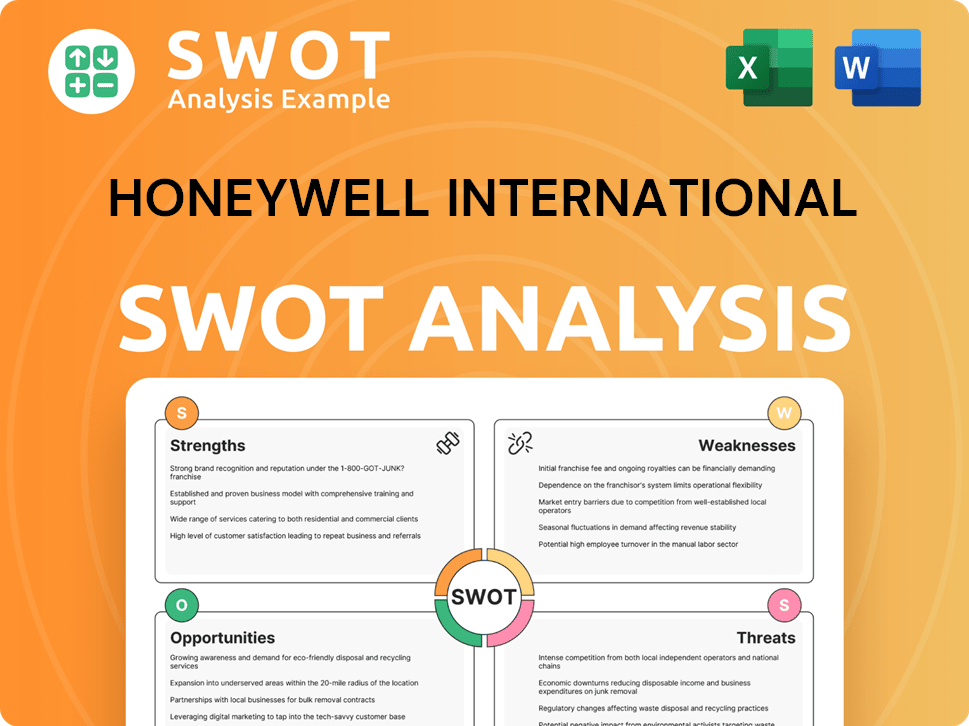
What Marketing Tactics Does Honeywell International Use?
Honeywell International employs a multifaceted approach to sales and marketing, leveraging both digital and traditional tactics. Their strategies are designed to build brand awareness, generate leads, and ultimately drive sales across its diverse business segments. A strong emphasis is placed on data-driven marketing and customer segmentation to tailor solutions effectively.
The company's marketing efforts are extensive and include a significant investment in digital channels, trade shows, and traditional advertising. This comprehensive strategy reflects Honeywell's commitment to reaching a wide audience and adapting to evolving market dynamics. The integration of digital tools and data analysis is critical to their current approach.
Honeywell's marketing tactics are designed to build awareness and drive sales. The company utilizes a mix of digital and traditional strategies, with a strong emphasis on data-driven marketing and customer segmentation. This approach allows Honeywell to target specific customer needs and optimize its marketing spend.
Honeywell's digital marketing strategy includes content marketing, SEO, paid advertising, email marketing, and social media engagement. In late 2024, the company allocated approximately $42.3 million to digital ad spending.
SEO efforts have resulted in over 310,000 identified keywords and approximately 300,000 monthly website visitors. This strong organic traffic highlights the effectiveness of their SEO strategy.
Honeywell actively engages on 15 global social media platforms. They have 1.2 million LinkedIn followers and 680,000 Twitter followers (2024). This broad social media presence helps in reaching various audiences.
LinkedIn generates 3.7 million impressions and reaches 62 million professional contacts. YouTube sees 4.2 million video views, reaching 18 million technology professionals. These platforms are key for professional networking and showcasing technology.
Honeywell expands its reach by collaborating with influencers. This helps in engaging diverse audiences through digital marketing tactics, enhancing brand visibility.
Honeywell participates in industry trade shows and conferences, such as the Consumer Electronics Show (CES). They attend 37 global technology events with a budget of $12.6 million, generating 14,500 qualified leads.
Honeywell's customer-centric approach involves understanding customer needs and tailoring solutions. This is supported by market segmentation surveys to gather customer-specific information and divide the market into homogeneous groups based on unique buying behavior. The company has also invested in analytics software and automation to enhance operational efficiency. For more details on the company's business model, consider reading about the Revenue Streams & Business Model of Honeywell International.
- Honeywell's digital transformation strategy includes using AI technology in its home and commercial building businesses.
- The company is rolling out e-commerce across the organization to fulfill customer needs and predict future purchases.
- This evolution in its marketing mix has moved away from solely relying on press releases and print brochures towards a more targeted, measurable, and digitally integrated approach.
- The company's sales strategy is also supported by a well-defined sales team structure, focusing on key market segments and customer needs.
Honeywell International PESTLE Analysis
- Covers All 6 PESTLE Categories
- No Research Needed – Save Hours of Work
- Built by Experts, Trusted by Consultants
- Instant Download, Ready to Use
- 100% Editable, Fully Customizable
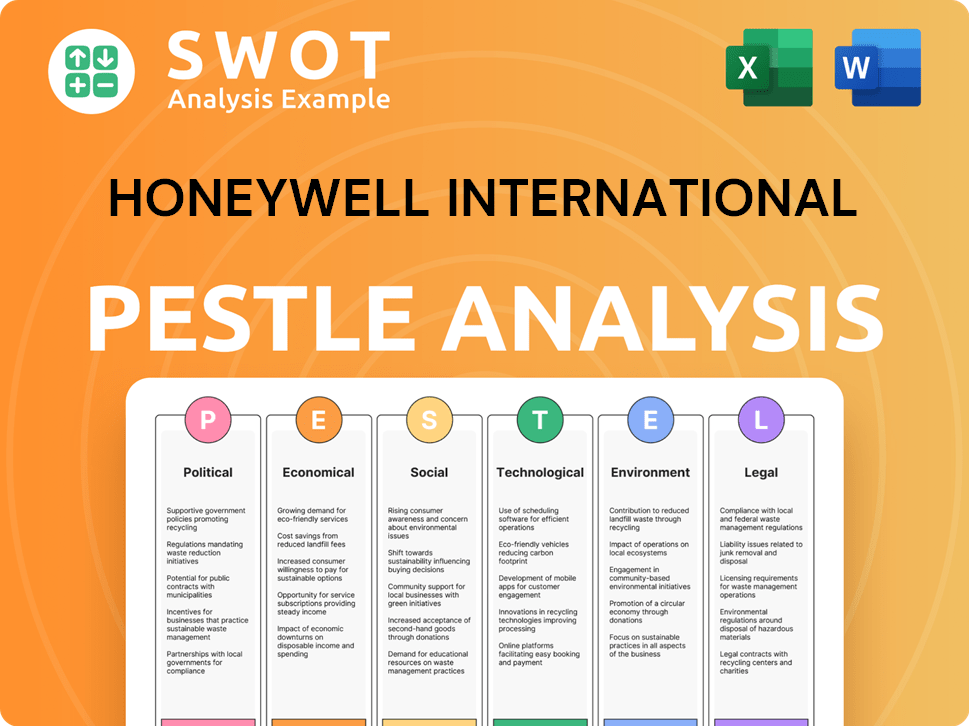
How Is Honeywell International Positioned in the Market?
The brand positioning of the [Company Name] centers on its identity as a global technology leader. The company communicates a core message focused on innovation, safety, efficiency, and sustainability, promising to build a safer, more secure, comfortable, energy-efficient, innovative, and productive world. This promise encapsulates the company's unique attributes and the benefits its technology solutions bring to a complex world.
The visual identity of the company prominently features the wordmark in Honeywell Red, complemented by Total Black and Brilliant White. The consistent use of Helvetica typeface contributes to a professional, comfortable, and reliable perception, ensuring a unified customer experience across various channels. This cohesive branding strategy is crucial for maintaining a strong market presence and customer trust.
The company differentiates itself by relentlessly pursuing technological breakthroughs, offering high-quality, reliable products, and solutions that address modern-day challenges. This commitment to technological leadership and its diversified portfolio across aerospace, building technologies, performance materials, and safety solutions, allows it to target a broad customer base. For example, approximately 60% of the company's R&D funding in 2023 focused on sustainability-oriented offerings, demonstrating its appeal through environmental responsibility and energy-efficient technologies.
The company emphasizes building a world that is safer, more secure, comfortable, energy efficient, innovative, and productive. This message highlights the company's commitment to improving various aspects of life through its technological solutions.
The visual identity includes the wordmark in Honeywell Red, along with Total Black and Brilliant White. The use of Helvetica typeface contributes to a professional and reliable brand perception. This consistency is maintained across all channels.
The company differentiates itself through relentless pursuit of technological breakthroughs and offering high-quality, reliable products. This approach addresses modern-day challenges and positions the company as a leader in innovation.
The company appeals to its target audience through its commitment to technological leadership and a diversified portfolio. This includes offerings in aerospace, building technologies, performance materials, and safety solutions.
The company's strong global brand recognition contributes to customer trust, acting as a barrier to entry for new competitors. Its focus on customer needs and operational excellence further enhances its competitive advantage and fosters customer loyalty. Continuous adaptation of product offerings based on customer feedback and research showcases its responsiveness to current trends and customer preferences. To understand more about the company's financial performance, consider the insights provided in Owners & Shareholders of Honeywell International.
Honeywell International Business Model Canvas
- Complete 9-Block Business Model Canvas
- Effortlessly Communicate Your Business Strategy
- Investor-Ready BMC Format
- 100% Editable and Customizable
- Clear and Structured Layout
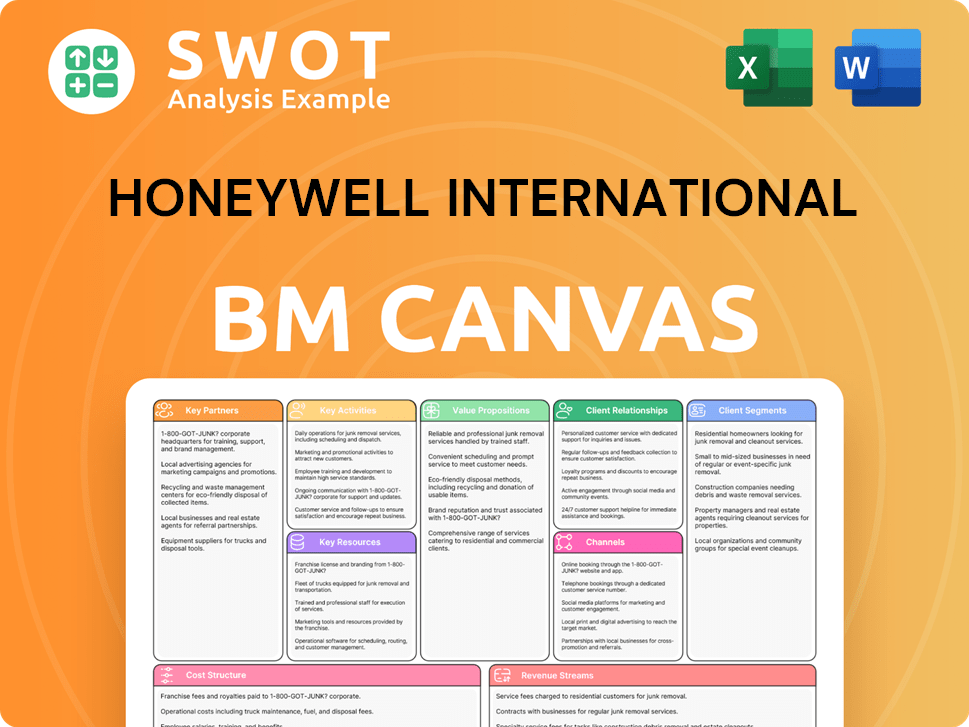
What Are Honeywell International’s Most Notable Campaigns?
Honeywell's sales and marketing strategy encompasses a diverse range of campaigns designed to boost brand awareness, engage customers, and drive growth. While specific details of recent campaigns from 2024-2025 are proprietary, insights from past campaigns and ongoing strategic initiatives reveal their approach. These campaigns often leverage both broad awareness efforts and highly targeted digital strategies to connect with diverse audiences.
The company's marketing efforts are not just about selling products; they are about building relationships and demonstrating value. This approach is evident in their focus on innovation, customer engagement, and strategic partnerships. Honeywell's marketing strategy aims to position the company as a leader in its various sectors, from aerospace to building technologies. The company's adaptable approach allows it to connect with diverse audiences and drive its business objectives.
A key element of the Honeywell sales and marketing approach is its ability to adapt to changing market conditions and customer needs. This flexibility is crucial in today's dynamic business environment. The company's strategic initiatives are designed to not only meet current demands but also anticipate future trends, ensuring long-term growth and sustainability. This includes investments in digital technologies and data analytics to enhance customer experiences and improve operational efficiencies.
In 2018, Honeywell launched the 'Healthy Sleep' campaign, featuring brand ambassador Kareena Kapoor Khan. The campaign aimed to educate consumers about the importance of healthy sleep and highlighted Honeywell's air purifiers. The 40-second TV commercial emphasized how Honeywell's Connected Building technologies contribute to achieving healthy sleep, addressing concerns about outdoor pollution affecting indoor environments.
In the summer of 2017, Honeywell executed a social media campaign targeting existing brand enthusiasts and potential new customers. The campaign used various video formats, including slideshows and stop-motion, addressing relatable summer issues. The campaign achieved a reach of over 161,000 people and 300,000 views, with 125,000 engagements and more than 150 website clicks.
The 'Clear the Air' digital campaign specifically targeted allergy sufferers and those affected by poor air quality due to wildfires. The campaign leveraged programmatic advertising with geotargeting based on high allergy/pollen counts and wildfire activity. This targeted approach highlights Honeywell's ability to address specific customer needs with tailored marketing efforts.
In 2024, Honeywell partnered with Google to integrate data with generative AI, aiming to streamline autonomous operations for its customers. This strategic move reflects Honeywell's commitment to innovation. This collaboration is part of a broader strategy to provide cutting-edge solutions and enhance customer value. Honeywell's focus on industrial customers is evident in this partnership.
Honeywell's sales and marketing strategy includes participation in major industry trade shows like CES, generating significant qualified leads. This underscores the company's commitment to engaging with customers and showcasing its latest innovations. For more details, you can explore the Growth Strategy of Honeywell International.
- Focus on digital marketing and data analytics to enhance customer experiences.
- Strategic partnerships to expand market reach and offer innovative solutions.
- Targeted campaigns to address specific customer needs and market segments.
- Participation in industry events to generate leads and build brand visibility.
Honeywell International Porter's Five Forces Analysis
- Covers All 5 Competitive Forces in Detail
- Structured for Consultants, Students, and Founders
- 100% Editable in Microsoft Word & Excel
- Instant Digital Download – Use Immediately
- Compatible with Mac & PC – Fully Unlocked
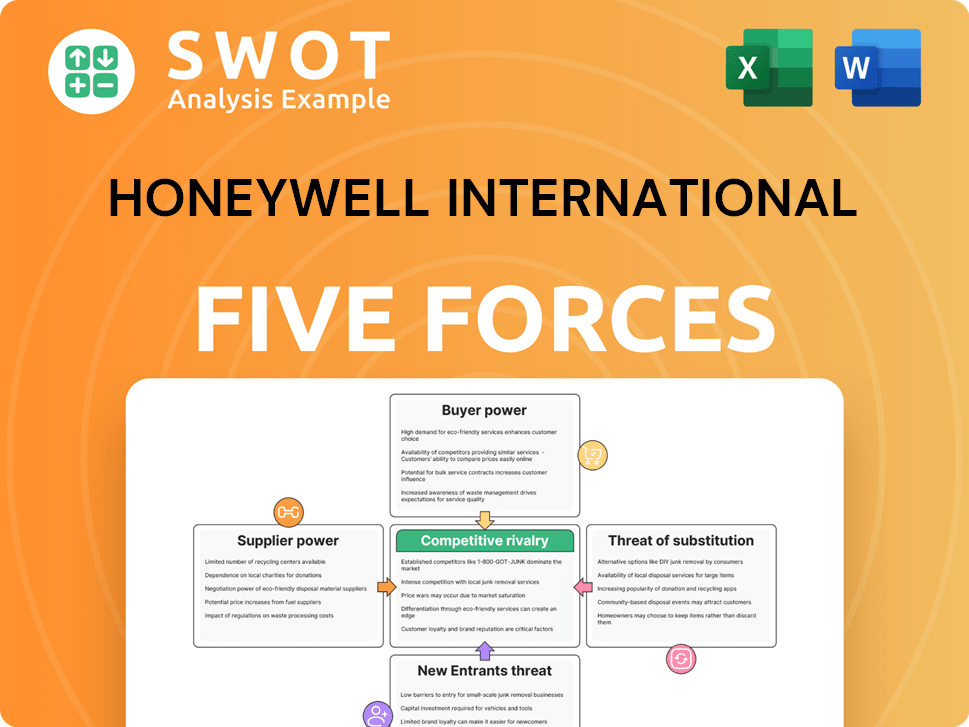
Related Blogs
- What are Mission Vision & Core Values of Honeywell International Company?
- What is Competitive Landscape of Honeywell International Company?
- What is Growth Strategy and Future Prospects of Honeywell International Company?
- How Does Honeywell International Company Work?
- What is Brief History of Honeywell International Company?
- Who Owns Honeywell International Company?
- What is Customer Demographics and Target Market of Honeywell International Company?
Disclaimer
All information, articles, and product details provided on this website are for general informational and educational purposes only. We do not claim any ownership over, nor do we intend to infringe upon, any trademarks, copyrights, logos, brand names, or other intellectual property mentioned or depicted on this site. Such intellectual property remains the property of its respective owners, and any references here are made solely for identification or informational purposes, without implying any affiliation, endorsement, or partnership.
We make no representations or warranties, express or implied, regarding the accuracy, completeness, or suitability of any content or products presented. Nothing on this website should be construed as legal, tax, investment, financial, medical, or other professional advice. In addition, no part of this site—including articles or product references—constitutes a solicitation, recommendation, endorsement, advertisement, or offer to buy or sell any securities, franchises, or other financial instruments, particularly in jurisdictions where such activity would be unlawful.
All content is of a general nature and may not address the specific circumstances of any individual or entity. It is not a substitute for professional advice or services. Any actions you take based on the information provided here are strictly at your own risk. You accept full responsibility for any decisions or outcomes arising from your use of this website and agree to release us from any liability in connection with your use of, or reliance upon, the content or products found herein.